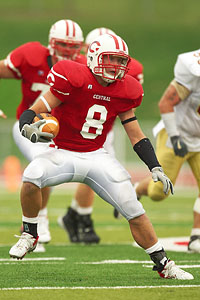I was listening to the “Mike and Mike” show on ESPN radio this morning and heard something that made my ears bleed. Jenn Brown was giving her report on the Thursday night match-up between #16 Florida State and N.C. State. FSU quarterback Christian Ponder has had some issues with his elbow yet has practiced this week. He told reporters that his injury was a “blessing in disguise” and is “starting to use my core more” when throwing (1). He fucking said “core”.
The term “core” has been demonized and written about plenty of times, and I won’t add too much to it here. It just sounds so…puny (I was going to write a similar word with different consonants, but you get the idea). Saying the word conjures up images of “personal trainers” having their clients do silly shit around the gym to make them sweaty and sometimes sore. More importantly, I don’t like “core” because the way it is said and perceived is lacking from an anatomical standpoint. Proponents of the term would cite the stability needed in the abdominals and back muscles to transfer force and move the body. That definition neglects the hips, which is the area of the body that is most important for acceleration (in the physics sense; in this case referring to a person’s change in velocity). We already know that barbell training is the best way to strengthen the hips (and subsequently the “core”), but I’m more concerned with the seeming misunderstanding of what is important for movement and acceleration.
In QB Ponder’s defense, he does mention his hips in improving his mechanics. What he’s saying is, “The elbow injury has forced me to use my hips in my throwing motion properly, and thus improves my ability to throw the football. Previously I wasn’t using my hips and primarily used my arm, and this is what caused the injury.” As referenced above, his actual first sentence was, “I’m starting to use my core more, which is something I got away from this year.” I don’t expect anybody to care what the term “core” does or doesn’t mean, but I have a problem with how it is perceived. It’s perceived to be abdominal related, and that means this is going to be the primary method of strengthening or improving the area:
Exercises like the squat, press, and deadlift not only strengthen the hips, but also the muscles that attach to the hips from the anterior and posterior. A quarterback will benefit from utilizing hip strength in a throwing motion — that’s why “setting the feet” is so important to football; it allows the quarterback to properly apply force to the ground to move and rotate his legs, hips, torso, and then arm to have a solid throw. This is also why it’s a horrible idea for a quarterback to roll right and throw to the left — there’s not power behind his throw (and the resulting vector the football makes as it travels at an angle across the field allows the defense to react and move towards the ball, but that’s a different point entirely).
You can look at any athletic movement and see how it’s completely dependent on the hips. Look at the picture below of a juke. This juke is quite exaggerated, yet it shows that in order to move to the right, the player has to apply force to the left. When an athlete moves fast, they only have one foot on the ground, so that one foot has to not only apply enough force to move the entire body in the desired direction, but often having to overcome the body’s own momentum (since they are changing directions) as well as any other exterior forces (in this case, other players — gravity is implied while we’re on Earth). In this particular picture, this ball carrier is probably* in the midst of moving left. A bland analysis would say he’s abducting his hip, but anyone who’s played a sport knows that’s stupid — stand up straight and move your left leg out away from your mid-line while keeping you knee straight. Is this how you juke? No. There is plantar flexion (ankle), knee flexion, and hip extension occurring to move laterally and forward. All of those muscles are worked through a full range of motion (with the exception of the plantar flexion muscles, but stay on track here) during a back squat. There’s a lot going on in a juke, but the point is that the abs are not the core of the movement.
It’s interesting to analyze movement, but you don’t have to focus on it while you watch football this weekend. Just know that the foundation for athletic movement comes from strengthening the major joints through a full range of motion, and this is best achieved through barbell training. Once there is a foundation of strength** you apply that strength into the movements and activities associated with a sport. That last part is the “conditioning” part of “strength and conditioning”. I just wish silly personal training rhetoric would stay out of it.
*I say probably because technically we don’t know what’s going on the photo. He could be spinning, or in a stutter step to move to the left, or spinning around after making a catch. Let’s just assume he’s juking to his right.
**Admittedly, the “foundation of strength” is arbitrary. I’d say it’s relative to age and skill level, but that is also another discussion.


